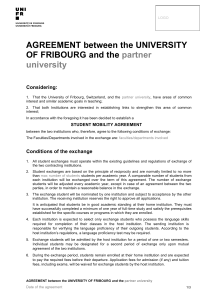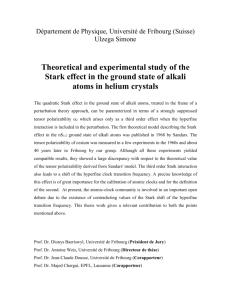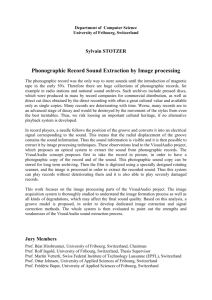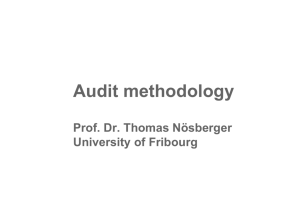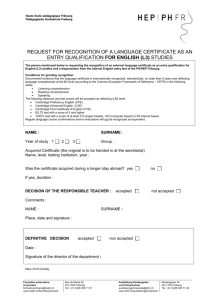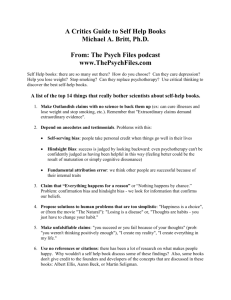The domain of suggestionality: Hindsight bias and other
advertisement
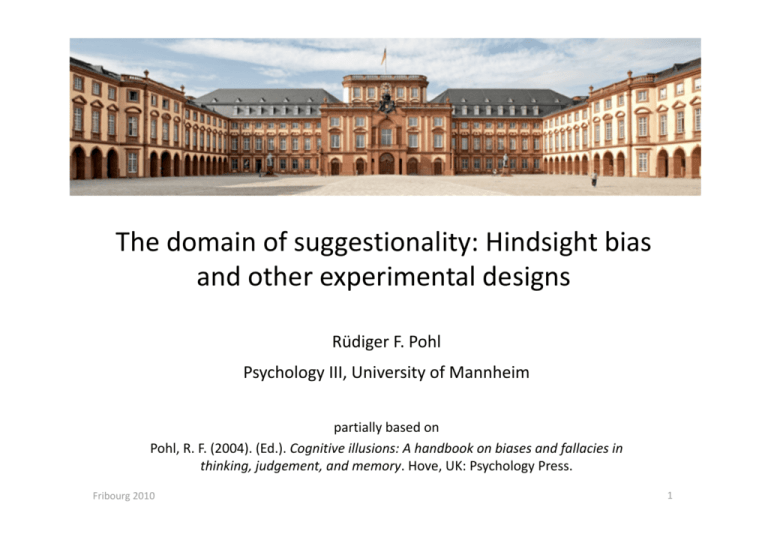
The domain of suggestionality: Hindsight bias and other experimental designs Rüdiger F. Pohl Psychology III, University of Mannheim partially based on Pohl, R. F. (2004). (Ed.). Cognitive illusions: A handbook on biases and fallacies in thinking, judgement, and memory. Hove, UK: Psychology Press. Fribourg 2010 1 Outline My research vita Introduction to cognitive illusions The domain of suggestionality Hindsight bias and other illusions Conclusions Fribourg 2010 2 My research vita Fribourg 2010 3 My research vita • • • First 5 years: Psycholinguistics – memory representations of … • verbs of possession • propositions/sentences • stories/story grammars All the time: Cognitive psychology – schema theory of information processing – memory errors/cognitive illusions • eyewitness‐misinformation effect • hindsight bias – traumatic memories – autobiographical memory Last 5 years: Decision making – heuristics Fribourg 2010 4 My research vita • Psycholinguistics: Propositional structure and phrase structure Fribourg 2010 5 My research vita • Psycholinguistics: Story grammar Fribourg 2010 (Mandler & Johnson, 1977) 6 My research vita • Cognitive psychology: Looking into the „black box“ Fribourg 2010 7 My research vita • Cognitive psychology: Schema theory of information processing Interpretation Selektion Abstraktion Integration Fribourg 2010 Rekonstruktion Episodische Gedächtnisspur Vergessen 8 My research vita • Cognitive psychology: Autobiographical memory Erste Freundin Essen gehen Beziehung mit X Ehe mit Y Tanzen gehen Telefonieren Erstes Treffen in F Telefonate Essen bei Luigi Fribourg 2010 Urlaub machen Urlaub in G Tanzen im Malibu Streitigkeiten Erster Kuss Eifersuchtsszene Perzeptive Details Perzeptive Details (Pohl, 2007; cf. Conway, 1992) 9 My research vita Fribourg 2010 10 My research vita • Decision making with heuristics: Adaptive toolbox metaphor Fribourg 2010 11 Introduction to cognitive illusions Fribourg 2010 12 Cognitive illusions Fribourg 2010 (2004) 13 Collections of cognitive illusions • – Hell, Fiedler, & Gigerenzer (1993). Kognitive Täuschungen. – Pohl (2004). Cognitive illusions. Thinking and judgment – – – – – • Tversky & Kahneman (1974). Judgment under uncertainty: Heuristic and biases. Kahneman, Slovic, & Tversky (1982). Judgment under uncertainty: Heuristic and biases. Edwards & von Winterfeld (1986). On cognitive illusions and their implications. Caverni, Fabre, & Gonzales (1990). Cognitive biases. Gilovich, Griffin, & Kahneman (2002). Heuristics and biases: The psychology of intuitive judgment. Memory – – – – – – Sully (1881), Hodgson & Davey (1886/1887) Bartlett (1932). Remembering: A study in experimental and social psychology. Schacter et al. (1995). Memory distortions. Roediger (1996). Memory illusions. Roediger & McDermott (2000). Memory distortions. Schacter (2001). The seven sins of memory. Fribourg 2010 14 An attempt to define cognitive illusions 1. Deviation from reality • Problem of choosing the “correct” normative model • • Necessity of a control group Mean effect summed across many trials • • Unconscious production Additional meta‐cognitive and motivational factors possible • Moderating effects of instruction, material, and procedures possible • • Distinction to “normal” errors (like forgetting and inferences) General information‐processing theories as explanations 2. Systematic deviation 3. Involuntary appearance 4. Impossibility to avoid 5. Specificity of phenomenon Fribourg 2010 (Pohl, 2004) 15 Domains of cognitive illusions 1. Thinking = application of a rule • • Examples: Estimate a probability, verify a logical conclusion, or discover a hidden rule Problem: Insufficient knowledge; intuitive application of rule 2. Judgment = subjective rating of a specific aspect • • Examples: Judgments of pleasantness, frequency, or veracity Problem: Influences of the given situation; uncertain knowledge 3. Memory = recall of earlier encoded information • Fribourg 2010 Problem: Reconstruction of partly forgotten material (Pohl, 2004) 16 A list of cognitive illusions • • Thinking 1. Conjunction fallacy 2. + 3. Bayesian inferences 4. Confirmation bias 5. Illusory correlation 6. Illusions of control 7. Biases in deductive reasoning Judgement 8. Availability 9. Judgments by representativeness 10. Anchoring effect 11. Validity effect Fribourg 2010 12. Mere exposure effect 13. Overconfidence 14. Pollyanna principle • Memory 15. Moses illusion 16. Orientation illusions in memory 17. Associative memory illusions 18. Effects of labeling 19. Misinformation effect 20. Hindsight bias 21. Illusions of change or stability (Pohl, 2004) 17 The domain of illusionality 1. Illusive situations (subjective reality ≠ objective reality) – perceiving illusion as reality – perceiving reality as illusion (= re‐interpreting reality) – perceiving reality as non‐reality (= selectively focussing) 2. Illusive techniques (procedures to yield cognitive illusions) 3. Illusionality (readiness to be illusioned) – general characteristics • restrictions to the cognitive system • ambiguous information, uncertainty – individual differences 4. Illusive functions – pessimistic vs. optimistic view – economy of cognitive ressources – coping (orientation, support, protection) Fribourg 2010 (Gheorghiu, Molz, & Pohl, 2004) 18 The debate on „Heuristics and biases“ (1999) (1982) (2002) (SPUDM 20, 2005, Stockholm) Fribourg 2010 19 The debate on „Heuristics and biases“ Pessimistic view Fribourg 2010 Optimistic view (Jungermann, 1986) 20 The debate on heuristics Com p of ac utationa l cap tor a more natural Fribourg 2010 (Simon, 1953) bilitie s more artificial 21 The domain of suggestionality Fribourg 2010 22 The domain of suggestionality What makes a person follow a suggestion? Fribourg 2010 23 The domain of suggestionality 1. Suggestive situations/phases a) perception of suggestive cues with demand characteristics b) acceptance/dominance of suggestive cues c) effectiveness of suggestive cues (e.g. cognitive illusions) 2. Suggestive techniques – e.g. plausibility, repetition, source characteristics 3. Suggestibility – general characteristics – individual differences • readiness to accept suggestions • standardized tests available 4. Suggestive functions Fribourg 2010 (Gheorghiu, 2000) 24 The domain of suggestionality Suggestive techniques General and individual suggestibility Person B accepts x Person A suggests x Suggestive situation Suggestive functions Fribourg 2010 (Gheorghiu, 2000) 25 The domain of suggestionality Fribourg 2010 26 Hindsight bias and other illusions Fribourg 2010 27 Anchoring and framing • Typical anchoring study – Comparative question: Is the percentage of African nations in the UN smaller or larger than 10% [65%]? – Exact‐estimate question: How large is it exactly? Fribourg 2010 (Tversky & Kahneman, 1974) 28 Anchoring and framing Fribourg 2010 29 Labelling Fribourg 2010 (Carmichael et al., 1932) 30 Labelling Fribourg 2010 (Carmichael et al., 1932) 31 Labelling Fribourg 2010 (Carmichael et al., 1932) 32 Labelling • • How fast were the cars going when they hit each other [smashed into each other]? Did you see broken glass on the ground? Fribourg 2010 (Loftus & Palmer, 1974) 33 Labelling • • Which color had the car passing a [the] barn? (Later:) Did you see a barn? Fribourg 2010 (Loftus, 1975) 34 Misinformation effect • Original slide (out of a series) • Questioning 1: Did another car pass the red car while it was stopped at the intersection with the yield [stop] sign? Questioning 2: Which traffic sign did you see at the intersection? • or Fribourg 2010 (Loftus, Miller, & Burns, 1978) 35 Misinformation effect Fribourg 2010 (Loftus, Miller, & Burns, 1978) 36 Implanting memories: Lost in the mall Fribourg 2010 (Loftus, 1993; Loftus & Pickrell, 1995) 37 Implanting memories: Lost in the mall • Example: Chris (in consecutive interrogations) – That day I was so scared that I would never see my family again. I knew that I was in trouble. – I remember mom telling me never to do that again. – I remember the man asking me if I was lost. I remember that old man’s flanell shirt. – I was with you guys for a second and I think I went over to look at the toy store, the Kay-bee toy and uh, we got lost and I was looking around and I thought, “Uh-oh. I’m in trouble now.“ You know. And then I … I thought I was never going to see my family again. I was really scared you know. And then this old man, I think he was wearing a blue flannel, came up to me … he was kind of old. He was kind of bald on top … he had like a ring of gray hair … and he had glasses. Fribourg 2010 (Loftus, 1993; Loftus & Pickrell, 1995) 38 Implanting memories: Childhood kidnapping attempt Fribourg 2010 Jean Piaget (1896-1981) 39 Implanting memories: Hot air balloon ride Fribourg 2010 (Wade et al., 2002) 40 Hindsight bias Example Fribourg 2010 (taken from Ash, 2009) 41 Hindsight bias Fribourg 2010 (Pohl, 2007) 42 Hindsight bias Memory design 93 80 72 Estimate Estimate Fribourg 2010 Solution Hindsight bias Recalled estimate Experimental Recalled estimate Control 43 Hindsight bias Hypothetical design 93 80 72 Estimate Control Fribourg 2010 Hindsight bias Solution Hypothetical estimate Experimental 44 Proportion of recalled estimates (%) Hindsight bias Estimate 20 Solution 15 10 Ctr. Exp. 5 0 -300 -200 -100 0 100 200 300 Bias index Fribourg 2010 45 Hindsight bias Fribourg 2010 (Pohl, 2004) 46 Hindsight bias • Memory‐based processes – memory impairment: Presentation of the correct solution impairs access to original judgment – source confusion: The correct solution is erroneously „recalled“ as the original judgment • Judgment processes – reconstruction bias: Reconstuction/memory search is biased by the correct solution (cf. anchoring) • Modell‐based separation of these processes – HB13 model (Erdfelder & Buchner, 1998) Fribourg 2010 47 Hindsight bias • Multinomial processing tree model: Control items Fribourg 2010 (Erdfelder & Buchner, 1998) 48 Hindsight bias • Multinomial processing tree model: Experimental items Fribourg 2010 (Erdfelder & Buchner, 1998) 49 Hindsight bias • Model equations Fribourg 2010 (Erdfelder & Buchner, 1998) 50 Hindsight bias • SARA (Selective Activation and Reconstructive Anchoring) Fribourg 2010 (Pohl et al., 2003) 51 Hindsight bias • SARA (Selective Activation and Reconstructive Anchoring) Fribourg 2010 (Pohl et al., 2003) 52 Hindsight bias • SARA (Selective Activation and Reconstructive Anchoring) Fribourg 2010 (Pohl et al., 2003) 53 Hindsight bias Fribourg 2010 (Pohl, Stahlberg, & Frey, 1999) 54 Hindsight bias Fribourg 2010 (Pohl & Hell, 1996) 55 Hindsight bias Fribourg 2010 (Pohl & Hell, 1996) 56 Hindsight bias Fribourg 2010 (Pohl, 1999) 57 Hindsight bias • High/low anchor design and source manipulation Fribourg 2010 (Pohl, 2000) 58 Hindsight bias • High/low anchor design and source manipulation Fribourg 2010 (Pohl, 2000) 59 Hindsight bias • High/low anchor design and plausibility manipulation Fribourg 2010 (Pohl, 2000) 60 Hindsight bias • High/low anchor design and plausibility manipulation Fribourg 2010 (Pohl, 2000) 61 Hindsight bias • High/low anchor design and plausibility manipulation Fribourg 2010 (Hardt & Pohl, 2003) 62 Age effects in hindsight bias • • Study 1: Young children vs. adults – New method: Visual degradation of common objects • Task: At which step can you (or could a peer) identify the object? • Design: Baseline (self) vs. Hindsight (other) condition Results: Children tend to show larger bias than adults Fribourg 2010 (Bernstein et al., 2004) 63 Age effects in hindsight bias • • Study 2: Older children vs. adults – Material: Almanac trivia questions Results (shift measure): Fribourg 2010 (Pohl, Bayen, & Martin, in press) 64 Age effects in hindsight bias • Results (multinomial modelling) – 3rd graders showed largest recollection bias (rc‐re) – 3rd graders showed largest reconstruction bias – 3rd graders showed most adoptions of correct judgment (CJ) Fribourg 2010 (Pohl, Bayen, & Martin, in press) 65 Age effects in hindsight bias • • Study 3: Lifespan development of hindsight bias Results: Difficulty of material – numbers of first judgments correct • on the mean 1.7 out of 48 judgments correct • no age difference Fribourg 2010 (Pohl, Auer, Bayen, & Martin, in prep.) 66 Age effects in hindsight bias • Results: Percentage of correct recollections – main effect of age group and experimental/control condition – significant interaction Interaction Bar Plot for Nkorrekt Effect: Gruppe Error Bars: 95% Confidence Interval 12 9 8 7 8 6 Cell Mean Cell Mean 10 6 5 4 3 4 2 2 0 Interaction Bar Plot for Nkorrekt Effect: Bedingung Error Bars: 95% Confidence Interval 1 0 Klasse3 Klasse6 Studis Oldies unmittelbar Cell Fribourg 2010 (Pohl, Auer, Bayen, & Martin, in prep.) simultan Cell control 67 Age effects in hindsight bias • Results: Source confusions – main effect of age group and experimental/control condition – significant interaction Interaction Bar Plot for NSourceConf Effect: Bedingung * Gruppe Error Bars: 95% Confidence Interval 1,4 Klasse3 1,2 Klasse6 Studis Cell Mean 1 Oldies ,8 ,6 ,4 ,2 0 Fribourg 2010 unmittelbar simultan Cell control (Pohl, Auer, Bayen, & Martin, in prep.) 68 Age effects in hindsight bias • Results: Shift of recalled judgments (hindsight bias) – hindsight bias in all age groups – main effects of age group and experimental/control condition – interaction nearly significant (p = .08) ,3 ,35 ,25 ,3 Interaction Bar Plot for ∆z Effect: Bedingung Error Bars: 95% Confidence Interval ,25 ,2 Cell Mean Cell Mean Interaction Bar Plot for ∆z Effect: Gruppe Error Bars: 95% Confidence Interval ,15 ,2 ,15 ,1 ,1 ,05 0 ,05 Klasse3 Klasse6 Studis Cell Fribourg 2010 Oldies 0 unmittelbar (Pohl, Auer, Bayen, & Martin, in prep.) simultan Cell control 69 Conclusions Fribourg 2010 70 The domain of suggestionality Suggestive techniques General and individual suggestibility Person B accepts x Person A suggests x Suggestive situation Suggestive functions Fribourg 2010 (Gheorghiu, 2000) 71 The domain of suggestionality • Suggestive techniques – state of uncertainty • all cognitive illusions [!] – inadequate representation • conjunction fallacy, base‐rate neglect, deductive reasoning – violation of general rules • conjunction fallacy, anchoring, Moses illusion, labelling, misinformation effect, implanting – confusions • Moses illusion, associative memory illusion – repetition • validity effect, mere‐exposure effect Fribourg 2010 72 The domain of suggestionality • General suggestibility – demand characteristics • base‐rate neglect, confirmation bias, labelling, misinformation effect, implanting – knowledge updating/coherence (“adaptive” learning) • anchoring, validity effect, associative memory illusion, labelling, misinformation effect, hindsight bias – efficient processing (heuristics) • anchoring, base‐rate neglect, confirmation bias – fluency/familiarity • validity effect, mere‐exposure effect, Moses illusion – self‐serving motives/coping Fribourg 2010 73 Self‐serving motives/coping Fribourg 2010 (Greenwald, 1980) 74 Self‐serving motives/coping Identity Fribourg 2010 (Kotre, 1998) 75 Summary • • Explanations of cognitive illusions – not all fully understood – often several, competing explanations – possibly multiple causes Influences of language – as medium of … • problem representation • instruction • memory representation – on cognitive processes in … • judgment • thinking • memory Fribourg 2010 76 Thank you for your attention! pohl@psychologie.uni‐mannheim.de Fribourg 2010 77
